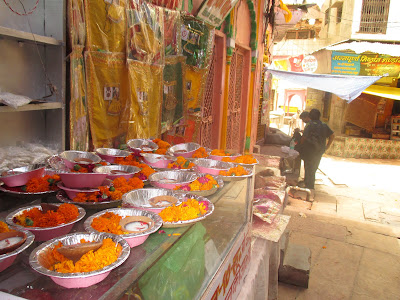In Mathura
Vishram Ghat is the most important ghat because the traditional
parikrama starts and ends at this place. It is said that Lord Krishna
rested here after killing Kamsa and his 8 brothers. Vishrama means “to
rest”. Before beginning Braj Mandal parikrama, pilgrims take bath on
this ghat. It is also said that Lord Chaitanya took bath in Vishram Ghat when they visited
Mathura.
People say that after killing Hiranyaksa, Lord Varaha (Lord Vishnu in
his boar incarnation) rested here. He spoke Adi Varaha Purana to
Bhudevi (Mother Earth) while resting in this place. Vyasadeva (a saint)
recorded Adi Varaha Purana
Every evening, there is a sunset arati offered to river Yamuna. Most
people visit this place in the evening especially for this arati. This
Ghat was reconstructed in the year 1814.
There is a small temple, Yamuna-Yamaraj Temple next to Vishram Ghat.
Other temples at this ghat are Annapurna Temple, Vasudeva Devaki Temple
and Krishna Balarama Temple.
The Yama Dvitiya Festival
is the famous
festival celebrated at Vishram Ghat on the second of Karttika Shukla.
Brothers and sisters bathe on Yama Dvitiya
As many as 50,000 people, brothers and sisters of all ages, representing
most of the northern states of India from Gujarat to Bengal, bathed in
the Yamuna on Sunday, especially at Vishram Ghat. The large number of
bathers freshened the memory of Kumbha Mela.
Tradition has it that the older sister takes her brother by the hand
and the two bathe together in the Yamuna. Yamuna is the twin sister of
Yamaraj, the god of death, and it is said that she intervenes on behalf
of brothers and sisters to protect them from the depradations of her
brother.
After bathing custom has it that the brother and sister go to the
Yamuna-Yamaraj temple and offer prayers there. Afterwards, the sister
marks her brother’s forehead with tilak, symbolizing her wishes for his
long life. Then they will exchange sweets and gifts and the brother
usually offers a sari or some other piece of clothing to his sister.
Yamaraj-Yamuna temple at Vishram Ghat
Many people started coming in the middle of the night to bathe, from
about 2 a.m. and the crowd remained constant until late afternoon. The
city was well prepared with boats and divers to be at the ready in case
of accident. Unfortunately, water levels near the ghats were low and
there was a lot of slippery mud everywhere, causing difficulty for
bathers.

With one exception, everything went smoothly. At about 10.30, city
drains overflowed at the nearby sewage treatment plant and there was an
influx of black water along the banks of the river, filling the bathing
area. Luckily, it was quickly noticed and taken care of so that the
disturbance was short-lived.
To help control the crowds, no vehicular traffic of any kind,
including two-wheelers, was allowed past the Holi Gate. Nevertheless,
the effect of the influx of pilgrims was felt in traffic jams throughout
the rest of the city.
The district prison was also a site where lines of women came to offer their best wishes to their incarcerated brothers.

Sister pours Yamuna water over younger brother.































